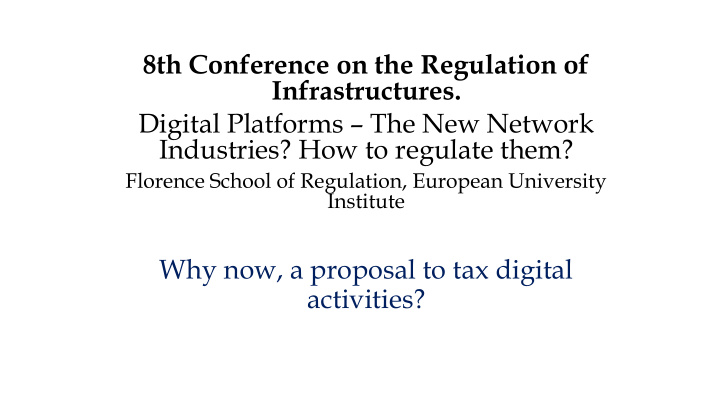



8th Conference on the Regulation of Infrastructures. Digital Platforms – The New Network Industries? How to regulate them? Florence School of Regulation, European University Institute Why now, a proposal to tax digital activities?
Outline • There is a difference between the intensive and extensive applications of digital technology • Challenges in establishing a relationship between extensive activities and jurisdictions • Separate taxation of intensive digital activities not advisable as they are closely related to traditional substitutes and tax principles
The M chart
How can we identify extensive applications of digital technology? Indicators Examples Not the means to an end but an end in itself Bitcoin, Cloud services Does not have an immediate traditional substitute Netflix would be an intensive application of digital technology although the product is digitized and e- commerce is engaged in, as immediate traditional substitutes are noted Service and product distinctions blurred Cloud services, Innovation platforms (Gawer and Evans, 2016), VR gaming Transformative in character (Thompson and Artificial general intelligence, Artificial super Shearman, 1978) intelligence, Autonomous Artificial Intelligence and smart factories “has this activity only arisen due to ICTs?” or “ the activity already existed before ICTs?” (( Heeks 2017) and (Narasimhan 1983))
Tax principles for the relationship between tax jurisdictions and business activities Tax principles Source based taxation Principle of ability to pay Benefits principle
Taxation issues – generally identified for digitalisation • Weak, invisible taxable economic presence (taxable person issue) • Heavy reliance on intangibles with the opportunity for base eroding payments tax • Value in data base • Characterization of income issue
Relationship between tax jurisdictions and extensive use of digital technologies Resources and benefits Electricity Internet Finance Regulatory business environment Customer and user participation Data
The Digital Services Tax proposed in Italy Italian Budget Law 2019 (Law no.145/2018) • Provision of advertising on a digital interface targeted to users of the same interface • Provision of a digital multilateral interface aimed at allowing users to interact (also in order to facilitate the direct exchange of good and services) • Transmission of data collected from users and generated by the use of a digital interface
Would the DST be fair? • Location of the user and the customer can be different, a withholding structure may not be effective. Apportionment and verification issues. • How much of the value created on the platform can be attributed to the platform provider? (e.g. users are not obliged to view advertisements) • Data as a type of raw material, issues in valuing data, use of data by traditional business models • These activities are intensive applications of digital technology • Example, daily users are consistently higher in Europe than in the US and Canada. However, the revenue per user ratio is consistently lower in Europe. This shows that the accounted income generated per jurisdiction is not always proportional to user population or network presence within an economy. (Facebook 10K report 2013, 2014 and 2015)
Conclusions • There is a difference between the intensive and extensive applications of digital technology • Challenges in establishing a relationship between extensive activities and jurisdictions • Separate taxation of intensive digital activities not advisable as they are closely related to traditional substitutes and tax principles Student under the supervision of Dr Ira Lindsay and Dr Carla Bonina, University of Surrey
Recommend
More recommend